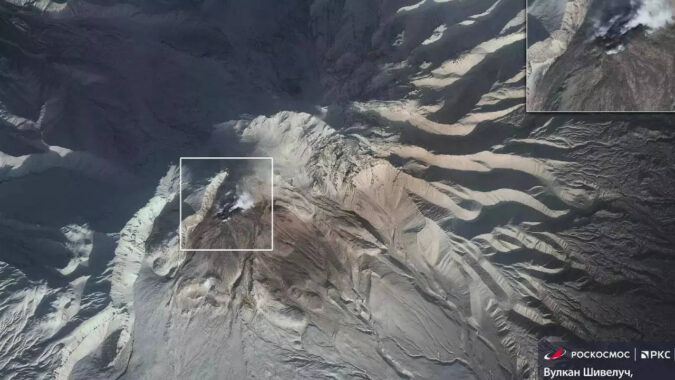Moscow: Russia’s Shiveluch volcano erupted on Tuesday, spewing ash across a vast swathe of the far eastern Kamchatka peninsula, potentially posing a risk to flights and paralysing several villages.
Dramatic videos published by officials showed a huge wall of ash rising above a snowy forest.
Volcanologists issued a red code warning for flights and Russia’s aviation authority Rosaviatsiya urged crews to “constantly monitor changes in meterological information”.
The Kamchatka Volcanic Eruption Response Team (KVERT), which monitors eruptions in the region, reported that the ash cloud had drifted hundreds of kilometres (miles) to the north and southwest of Shiveluch.
“An extrusive eruption of the volcano continues. Ash clouds of up to 15 kilometres (49,200 feet) tall … could occur at any time. Ongoing activity could affect international and low-flying aircraft,” the KVERT said in its red code alert notice.
Rosaviatsiya said it had issued a notice to plane crews asking them to ensure their flights were safe.
It added that regional air traffic management teams were “ready to assist crews of Russian and foreign airlines in chosing alternative safe routes”.
The governor of Kamchatka, Vladimir Solodov, said that three villages — Kliuchy, Kozyrevsk and Mayskoye — had been the worst affected. He urged people there to stay at home and announced that schools had been closed.
The remote rural villages lie on the Kamchatka river on the eastern side of the peninsula.
“As much as possible, stay at home,” Solodov said on Telegram.
“We are waiting for the forecasts of volcanologists monitoring the eruption to assess how long the ashfall will last.”
He said schools would switch to remote classes “for the duration of the aftermath of the disaster”.
Solodov said there were “some problems with water supply” and the authorities were delivering bottled water.
He said health officials had “gone went into every house, every apartment” in the villages to check on residents.
According to KVERT, Shiveluch is between 60,000 and 70,000 years old, and is one of the largest volcanoes in Kamchatka.
The Kamchatka Peninsula is sparsely populated.
The Smithsonian Institution’s Global Volcanism Program estimates that fewer than 12,000 people live within a 100-kilometre radius of Shiveluch.
Dramatic videos published by officials showed a huge wall of ash rising above a snowy forest.
Volcanologists issued a red code warning for flights and Russia’s aviation authority Rosaviatsiya urged crews to “constantly monitor changes in meterological information”.
The Kamchatka Volcanic Eruption Response Team (KVERT), which monitors eruptions in the region, reported that the ash cloud had drifted hundreds of kilometres (miles) to the north and southwest of Shiveluch.
“An extrusive eruption of the volcano continues. Ash clouds of up to 15 kilometres (49,200 feet) tall … could occur at any time. Ongoing activity could affect international and low-flying aircraft,” the KVERT said in its red code alert notice.
Rosaviatsiya said it had issued a notice to plane crews asking them to ensure their flights were safe.
It added that regional air traffic management teams were “ready to assist crews of Russian and foreign airlines in chosing alternative safe routes”.
The governor of Kamchatka, Vladimir Solodov, said that three villages — Kliuchy, Kozyrevsk and Mayskoye — had been the worst affected. He urged people there to stay at home and announced that schools had been closed.
The remote rural villages lie on the Kamchatka river on the eastern side of the peninsula.
“As much as possible, stay at home,” Solodov said on Telegram.
“We are waiting for the forecasts of volcanologists monitoring the eruption to assess how long the ashfall will last.”
He said schools would switch to remote classes “for the duration of the aftermath of the disaster”.
Solodov said there were “some problems with water supply” and the authorities were delivering bottled water.
He said health officials had “gone went into every house, every apartment” in the villages to check on residents.
According to KVERT, Shiveluch is between 60,000 and 70,000 years old, and is one of the largest volcanoes in Kamchatka.
The Kamchatka Peninsula is sparsely populated.
The Smithsonian Institution’s Global Volcanism Program estimates that fewer than 12,000 people live within a 100-kilometre radius of Shiveluch.
